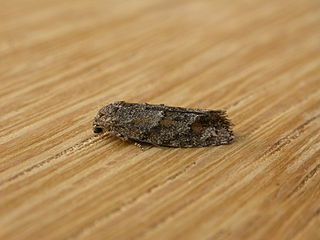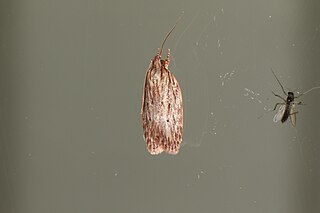
Agriophara nodigera is a moth of the family Depressariidae. It is found in Australia, where it has been recorded from Queensland.
Garrha costimacula is a moth in the family Oecophoridae. It was described by Edward Meyrick in 1883. It is found in Australia, where it has been recorded from Queensland and New South Wales.
Pseudotelphusa oxychasta is a moth of the family Gelechiidae. It is found in Namibia, South Africa and Zimbabwe.
Sorotacta viridans is a moth in the family Gelechiidae. It was described by Edward Meyrick in 1914. It is found in Guyana.
Antaeotricha cycnolopha is a species of moth of the family Depressariidae. It is found in Peru.
Stenoma chloroloba is a moth of the family Depressariidae. It is found in Peru, French Guiana, Guyana and Brazil.
Antaeotricha doleropis is a moth of the family Depressariidae. It is found in Guyana.
Chlamydastis fragmentella is a moth of the family Depressariidae. It is found in French Guiana and Guyana.
Antaeotricha sarcinata is a moth of the family Depressariidae. It is found in French Guiana.
Enchocrates phaedryntis is a moth in the family Depressariidae. It was described by Edward Meyrick in 1888. It is found in Australia, where it has been recorded from Western Australia.
Pedois cosmopoda is a moth in the family Depressariidae. It was described by Alfred Jefferis Turner in 1900. It is found in Australia, where it has been recorded from Queensland and New South Wales.
Pedois rhodomita is a moth in the family Depressariidae. It was described by Alfred Jefferis Turner in 1900. It is found in Australia, where it has been recorded from Queensland.

Pedois ceramora is a moth in the family Depressariidae. It was described by Edward Meyrick in 1902. It is found in Australia, where it has been recorded from Victoria.
Pedois sarcinodes is a moth in the family Depressariidae. It was described by Edward Meyrick in 1921. It is found in Australia, where it has been recorded from South Australia.
Pedois tripunctella is a moth in the family Depressariidae. It was described by Francis Walker in 1864. It is found in Australia, where it has been recorded from Tasmania.
Antaeotricha isosticta is a moth in the family Depressariidae. It was described by Edward Meyrick in 1932. It is found in Mexico.
Antaeotricha isotona is a species of moth in the family Depressariidae. It was described by Edward Meyrick in 1932. It is found in Panama.
Cerconota tabida is a moth in the family Depressariidae. It was described by Arthur Gardiner Butler in 1877. It is found in the Brazilian states of Amazonas and Pará and in the Guianas.
Chlamydastis crateroptila is a moth in the family Depressariidae. It was described by Edward Meyrick in 1918. It is found in French Guiana.
Imma eriospila is a species of moth in the family Immidae. It was described by Edward Meyrick in 1922. It is found in Pará, Brazil.

